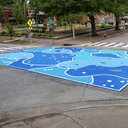Painted streetscapes brighten cities — and save lives

Streetscape art — think colorful crosswalks and painted intersections — can do a lot to liven up communities and make streets more welcoming. Yet it might seem like a potential distraction for drivers.
- But new research shows the opposite is true: Painted roadways often make intersections safer by encouraging motorists to slow down and be on the lookout for pedestrians and cyclists.
Why it matters: American roads have been getting deadlier amid a surge in reckless driving, which worsened during the pandemic. Nearly 40,000 people die on U.S. roadways ever year, and pedestrian deaths are up 45% in the past decade.
- Safety advocates say street design is a big contributor: U.S. roads prioritize automobiles over other road users like pedestrians and cyclists.
What's happening: To make communities more walkable, many cities have painted colorful crosswalks and murals over drab stretches of asphalt and concrete.
- Bloomberg Philanthropies, founded by former New York Mayor Michael Bloomberg, is a leading proponent of the strategy. It provides grants to help cities transform their streets and bridges into colorful works of art through its Asphalt Art Initiative.
Yes, but: The federal government is no art fan — at least when it comes to painting streets.
- The Federal Highway Administration has cracked down on communities for crosswalk art that doesn't conform to its uniform standards for road markings.
- Critics, including the National Association of City Transportation Officials, counter that the government has no data to back up its stance.
Driving the news: Bloomberg Philanthropies commissioned the first known study of street art to see what effect, if any, the pavement paintings have on traffic safety.
- Sam Schwartz Consulting, a well-known New York-based traffic research firm, compared historical crash data and real-time video footage of human behavior before and after the art was installed at 22 sites.
What they found: City streets became considerably safer for pedestrians after incorporating art into roadway redesigns.
- The data showed a 50% drop in crashes involving pedestrians or cyclists and a 37% drop in crashes leading to injuries. Overall, intersections with asphalt art saw a 17% reduction in total accidents.
- The videos showed a 27% increase in the rate of drivers yielding to pedestrians with the right of way, and a 25% drop in potentially dangerous conflicts between drivers and pedestrians.
What they're saying: Anything that "humanizes" the roadway environment is a safety benefit, Michael Flynn, Schwartz's national director of transportation planning, tells Axios.
- "It’s all psychological," he explains. "Traffic engineering is a social science. You're changing driver expectations. Things that constrain their field of vision and physically constrain the roadway" cause drivers to recognize that they're entering an area where they might encounter pedestrians.
What to watch: The Schwartz study is timely: The Federal Highway Administration is currently revising its Manual on Uniform Traffic Control Devices, the blueprint that governs everything from street lights and signage to pavement markings across the U.S.